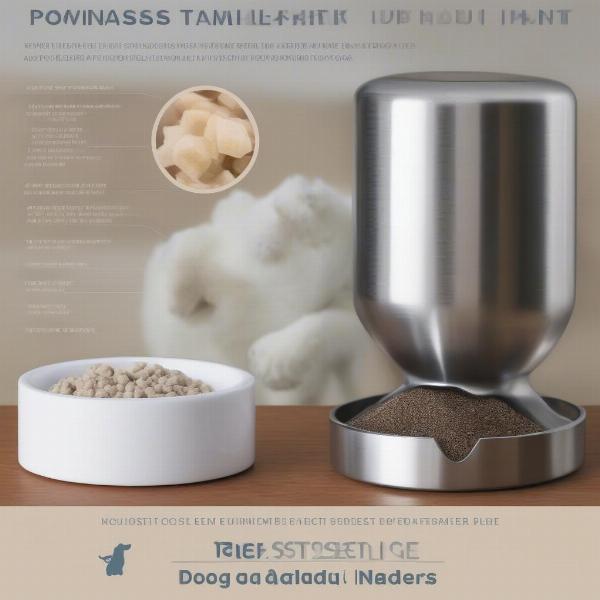A three bowl dog feeder can be a great addition to your dog’s mealtime routine, providing designated spaces for food, water, and even a third bowl for treats, supplements, or a different type of food. But with so many options available, how do you choose the right three bowl dog feeder for your furry friend? This guide will delve into the key factors to consider when selecting a three bowl dog feeder, ensuring your dog’s dining experience is comfortable, healthy, and enjoyable.
Factors to Consider When Choosing a Three Bowl Dog Feeder
Several factors influence the ideal three bowl dog feeder for your dog. Size, material, and design all play a role in creating a positive dining experience. Let’s explore these in more detail:
Size and Height
Choosing the right size and height is crucial for your dog’s comfort and digestive health. A feeder that’s too low can strain their neck and back, especially for older dogs or those with arthritis. Conversely, a feeder that’s too high can be awkward and difficult to eat from. Consider your dog’s breed, size, and age when determining the appropriate height. For puppies, an adjustable height feeder can be a great investment, allowing it to grow with them.
Material and Durability
Three bowl dog feeders come in a variety of materials, each with its own pros and cons. Stainless steel is a popular choice due to its durability, hygiene, and ease of cleaning. Plastic feeders are often more affordable and come in a wider range of colors and designs, but they may not be as durable as stainless steel. Ceramic feeders can be stylish and dishwasher-safe, but they are more prone to chipping or breaking. Consider your dog’s chewing habits and lifestyle when choosing the material. A heavy-duty, chew-proof feeder might be necessary for a dog prone to chewing.
 Durable Materials for 3-Bowl Dog Feeders
Durable Materials for 3-Bowl Dog Feeders
Design and Features
Three bowl dog feeders are available in various designs, from simple and functional to more elaborate and stylish. Some feeders come with non-slip bases to prevent spills and sliding, while others have raised stands to promote better posture. Consider your dog’s eating habits and any specific needs they may have. For example, a slow feeder bowl can be beneficial for dogs who eat too quickly. For larger dogs, check out our big dogs menu guide for dietary advice.
Benefits of Using a Three Bowl Dog Feeder
A three bowl dog feeder can provide several benefits for your canine companion. It allows you to offer different types of food, water, and even treats or supplements all in one convenient location. This can be especially helpful for dogs with specific dietary needs or those who require medication mixed with their food. A dedicated water bowl within the feeder ensures your dog always has access to fresh water.
Keeping Feeding Areas Tidy
Three bowl feeders can help keep your dog’s feeding area cleaner and more organized. By containing the food and water in designated bowls, you can minimize spills and messes. This is particularly useful for messy eaters or dogs who tend to knock over their bowls.
“A designated feeding station can drastically improve mealtime hygiene, making clean-up a breeze,” says Dr. Emily Carter, DVM, a veterinary nutritionist with over 15 years of experience.
Choosing the Right Feeder for Your Dog’s Life Stage
A puppy’s needs are different from a senior dog. Puppies might benefit from a smaller, adjustable elevated three bowl dog feeder to accommodate their growth, while senior dogs might need a raised feeder to ease joint pain. If you have a small breed, check out our dry dog food for small dogs.
Conclusion
Choosing the right three bowl dog feeder involves careful consideration of your dog’s individual needs. By assessing their size, age, eating habits, and any specific health concerns, you can select a feeder that promotes their comfort, health, and overall well-being. A well-chosen three bowl dog feeder can enhance mealtimes, making them more enjoyable for both you and your furry friend. Don’t forget to consider using a dog food puzzle for added mental stimulation.
FAQs
- Are stainless steel bowls better than plastic? Stainless steel is generally more durable and hygienic than plastic.
- What height should my dog’s feeder be? The ideal height depends on your dog’s size and age; it should allow them to eat comfortably without straining.
- Can I put a three bowl feeder in the dishwasher? This depends on the material of the feeder. Stainless steel and ceramic are usually dishwasher safe, while plastic may not be.
- Are elevated feeders good for all dogs? Elevated feeders can be beneficial for some dogs, particularly larger breeds and senior dogs, but they may not be suitable for all dogs.
- How often should I clean my dog’s feeder? You should clean your dog’s feeder daily to prevent bacteria buildup.
- What if my dog tips over their three bowl feeder? Look for a feeder with a non-slip base or consider a weighted feeder.
- Can I use a three bowl feeder for multiple dogs? Yes, you can, but ensure each dog has adequate space to eat without competition. If your dogs have different dietary needs, consider separate feeders.
ILM Dog is your trusted source for expert advice on all aspects of dog care, from breed selection to nutrition and training. We provide comprehensive resources and personalized guidance to help you navigate the joys and challenges of dog ownership. Whether you’re looking for information on choosing the perfect metal dog bowl or understanding the specific needs of your breed, ILM Dog is here to support you every step of the way. Contact us today at [email protected] or +44 20-3965-8624 to learn more.